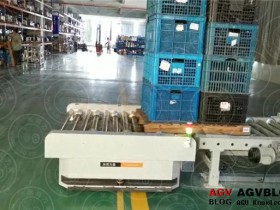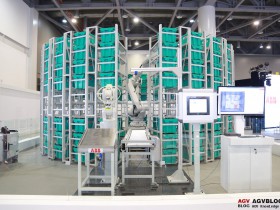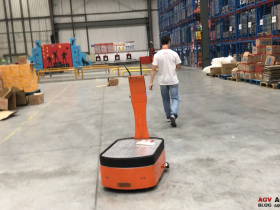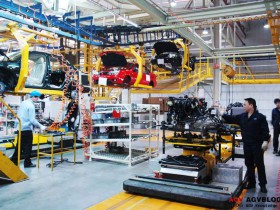The application of AGV is very extensive, and the research involves a variety of technical fields. It is a typical mechatronics multi-technology and multi-disciplinary integrated system. With the development of electronics and control technology, AGV's technology is also constantly improving, and is developing towards superior performance, cheaper, higher degree of freedom, ultra-large size and miniaturization. Its application field is also expanding and achieving good results.
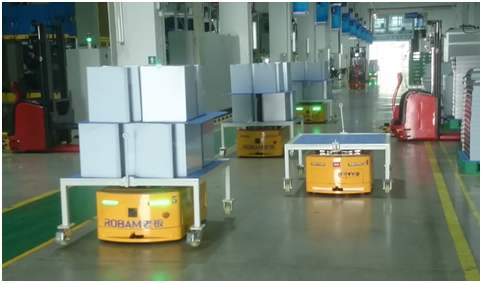
3.1 Material handling
In modern material handling, when the total cost of the person and the handling tool used is substantially the same as the cost of using the AGV automated guided vehicle, the market acceptance of the AGV will naturally take shape. The labor costs of developed countries such as Europe, America and Japan are very high, so the use of AGV is more popular and the application is applicable to all walks of life. At present, there are about 20,000 various AGVs in the world running in 2,100 large and small warehouses.
In the three-dimensional warehouse of the development zone that Haier Group put into operation in 2000, nine AGVs formed a flexible in-house automatic handling system, successfully completing the task of handling 23,400 tons of goods and components in and out of the warehouse every day. Yuxi Hongta Group and Honghe Cigarette Factory use the laser-guided AGV to carry out cargo handling.
Other industries such as chemical raw materials and finished products; components in the instrumentation industry; paper in the printing and publishing industry; chips in the electronics industry; computers; cans and beverages in the food industry; cotton yarns and fabrics in the textile industry; linings and fabrics in the clothing industry , clothing; parts of the automobile industry; steel ingots, steel strips, plates in the metallurgical industry; banknotes, coins, gold in the financial system; raw materials and finished medicines in the pharmaceutical manufacturing industry; and the handling of national defense such as weapons and ammunition, military supplies, etc.
3.2 Flexible assembly line, processing line
Traditional production lines are generally composed of a continuous rigid conveying device, which is several meters long and several kilometers long, such as automobile assembly lines and cylinder processing lines.
The outstanding problems are:
(1) Require the uniformity of the beat of each process, otherwise it will affect the progress of the entire production line due to the delay of any one process, such as lack of materials, missing parts, waste products or unexpected problems.
(2) The requirements for the plant are very large and very long (for larger and heavier cranes to be used for driving), the cost of civil works is high.
(3) The continuous production line cuts off the passage, causing the supply line to be long, and people and vehicles are inconvenient in the past.
(4) Continuous production lines require a large amount of equipment and the investment cost is high.
(5) The rigid production line makes some work that can be synchronized and cross-cutted lost opportunities.
After the emergence of AGV, it can be used not only as an unmanned automatic handling vehicle, but also as a movable assembly station and processing station. They can work independently and independently, and can accurately and orderly connect and form without Physically partitioned, but capable of dynamic regulation, a highly flexible production line. Such as car assembly line, engine assembly line, test line, machine tool processing line, home appliance production line.
In 1974, in order to improve the flexibility of the transport system, the Volvo Kalmar sedan assembly plant in Sweden adopted an automatic car assembly line based on AGVS as a carrier. The assembly line consists of several AGVSs that can be loaded with the car body. After the assembly line, the assembly time is reduced. 20%, assembly failures reduced by 39%, investment recovery time reduced by 57%, labor reduced by 5%. At present, AGV has been widely used in the manufacturing and assembly lines of major automotive plants in the world, such as GM, Toyota, Chrysler, and Volkswagen.
3.3 for special occasions
AGV unmanned automatic handling solves some special environmental problems in which people are not suitable for production or work. Such as nuclear materials, dangerous goods (pesticide, toxic, corrosive, biological, flammable and explosive materials). In steel plants, AGV is used for the transportation of furnace materials, which reduces the labor intensity of workers. In places where nuclear power plants and nuclear radiation are used for fresh-keeping storage, AGVs are used for the transport of goods and avoid dangerous radiation. In film and film warehouses, AGV delivers materials and semi-finished products accurately and reliably in dark environments.
The industries that use more AGVs in China mainly include the tobacco industry and the automotive industry, and more than 20 have adopted AGV. Due to the lucrative profits, the tobacco industry is the most widely used area of AGV, accounting for about half of the total sales of AGV. Although AGV has applications in the automotive industry, the number is small, because China's auto companies are small in scale and relatively thin in profits; There are also requirements for AGV applications, but overall, the application range of domestic AGVs is still relatively narrow, and the technology and demand are not very mature. AGV manufacturers are needed for further guidance, and AGV systems adapted to different industries are developed to improve the corresponding The degree of production automation and production efficiency of the industry.

